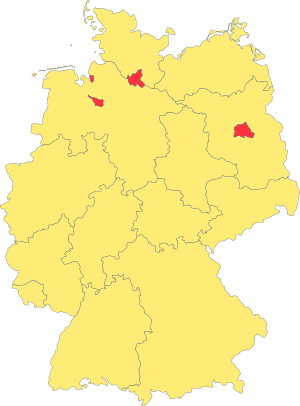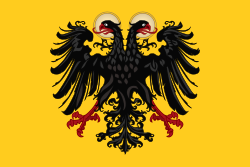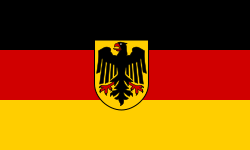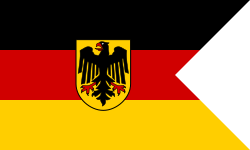Německá vlajka


 Německá vlajka
Německá vlajkaPoměr stran: 3:5

 Německá státní vlajka
Německá státní vlajkaPoměr stran: 3:5

 Německá námořní válečná vlajka
Německá námořní válečná vlajkaPoměr stran: 3:5
Vlajka Německa je tvořena listem o poměru stran 3:5 se třemi vodorovnými pruhy, černým, červeným a žlutým.[1] (Německý základní zákon uvádí z historických důvodů černou, červenou a zlatou.)[2] Nepřetržitě je vlajkou Spolkové republiky Německo od roku 1949.[3]
Státní (služební) vlajka navíc nese štít s upraveným státním znakem, její soukromé užití ani užití obcemi či spolkovými zeměmi není přípustné. Vedle národní vlajky je neoficiálně tolerováno i užití vlajky se státním znakem.
- Vlajka německého prezidenta
Poměr stran: 1:1 - Neoficiální německá vlajka se státním znakem
Poměr stran: 3:5
Historie
Černo-červeno-žlutá trikolóra, kterou v roce 1813 užíval dobrovolnický sbor Ludwiga Adolfa Wilhelma von Lützow, se stala symbolem německého boje proti Napoleonovi. Její barvy byly odvozeny z barev říšského znaku – černého orla s červenou zbrojí na zlatém poli. I po napoleonských válkách byla tato vlajka chápána jako symbol německého liberalismu. V roce 1848 ji frankfurtský sněm vyhlásil za oficiální vlajku německého spolku.
V roce 1871, když se po vyhrané válce proti Francii spojil Severoněmecký spolek s ostatními německými státy do jednotného německého císařství pod vládou pruské dynastie, stala se vlajkou tohoto útvaru černo-bílo-červená trikolóra používaná už od roku 1866 Severoněmeckým spolkem. Černá a bílá byly barvami Pruska, zatímco červená a bílá zastupovaly hanzovní města.
Po vzniku republiky se od 11. srpna 1919 začaly v Německu vztyčovat opět vlajky černo-červeno-žluté. Adolf Hitler se 13. března 1933 vrátil k císařské vlajce, spolu s ní se mohla vztyčovat vlajka NSDAP, ta se stala 15. září 1935 jedinou německou vlajkou.
V září roku 1949 byla vyhlášena SRN a o měsíc později NDR, oba státy se vrátily k barvám černo-červeno-žluté. V NDR byl však v roce 1959 na vlajku vložen státní znak. Po znovusjednocení Německa v roce 1990 je černo-červeno-žlutá trikolóra opět vlajkou celého Německa.
Historické vlajky
Svatá říše římská
 začátek 15. století
začátek 15. století
- válečné vlajky:
 15. století (Reichssturmfahne)
15. století (Reichssturmfahne) 15. století (Reichsrennfahne)
15. století (Reichsrennfahne)
Německý a severoněmecký spolek, Německé císařství
Německo 20. století
Vlajky německých spolkových zemí
Německo se člení na 16 spolkových zemí. Všechny země užívají vlastní vlajku, Bavorsko má dokonce dvě oficiální vlajky.
Odkazy
Reference
Související články
Externí odkazy
 Obrázky, zvuky či videa k tématu Německá vlajka na Wikimedia Commons
Obrázky, zvuky či videa k tématu Německá vlajka na Wikimedia Commons
Média použitá na této stránce
Autor: DoktorMandrake, Licence: CC BY-SA 3.0
IFIS for "historical version" (not part of original set of symbols)
Autor: David Liuzzo, eagle by N3MO, Licence: CC BY-SA 3.0
Banner of the Holy Roman Empire, double headed eagle with halos (1400-1806)
Autor: Sir Iain, eagle by N3MO, Licence: CC BY-SA 3.0
Banner of the Holy Roman Empire, with the arms of Austria.
Flag of the Germans(1866-1871)
Flag of the Germans(1866-1871)
National flag and merchant ensign of Germany from 1933 to 1935.
National flag and merchant ensign of Germany from 1933 to 1935.
Autor: Tijmen Stam (User:IIVQ), Licence: CC BY 2.5
Vexillological symbol according to FIAV / W. Smith
This symbol in particular means that the flag is the current and official flag of the group or nation.
Bundesdienstflagge (Flag of the federal authorities of Germany). Under German law, federal states, municipalities, institutions or private persons are not allowed to use this flag.
Merchant flag of Germany under Allied occupation (1946-1950).
Autor: Sir Iain, eagle by N3MO, Licence: CC BY-SA 3.0
Banner of the Holy Roman Empire, with the combined Arms of Austria and Burgundy. Used during the reign of Maximilian I and Charles V.
National flag and merchant ensign of Germany from 1933 to 1935.
Autor: Proof02, Licence: CC BY-SA 3.0
Banner of Charles V as Holy Roman Emperor (1519-1556).
State flag of Germany with coat of arms instead of 'federal shield' (unofficial variant).
Autor: Roman Poulvas, David Liuzzo, Licence: CC BY-SA 2.0 de
Map of States of Germany (Area States & City States)
Reichststurmfahne (military banner used by the Holy Roman Emperor during ca. 1200-1350).
- The Reichssturmfahne was not a flag, but a banner. Meyer's Lexikon of 1897 says s. v. Banner: " [...] When investing a fief, the Emperor had together with this Imperial banner in black and yellow a second banner in red for the investion with penal judicature. This is probably the reason of combining the colours black, red and yellow to form a tricolor against the rules of heraldry...The Reichssturmfahne was smaller than the Imperial banner, more like a chaffron... [...] The banner of the Holy Empire bore a cross even before 1200; it is the St. George's banner... Emperor Friedrich III took the cross officially as part of the Imperial arms, but some of his successors did not use it." A. Birken, 22 Aug 2002
Reichsrennfahne, one of the old emblems of the Holy Roman Empire, warflag of the King of Germany/Roman Kaiser (heraldic flag)
Autor: David Liuzzo, eagle by N3MO, Licence: CC BY-SA 3.0
Banner of the Holy Roman Empire, double headed eagle with halos (1400-1806)
Anachronistic representation of the royal banner of the 12th(?) or 13th to early 15th centuries.
The banner of this period would be square in shape, and the eagle would not have a halo.
The black eagle in a golden field was the ensign of the German kings (as opposed to the emperor) in the 12th and 13th century, but in the 14th century, it was gradually re-interpreted as representing the empire. An early reference to such a banner as "imperial" is made in an account of the burial of Charles IV (d. 1378), as der schwartz adler des richs in einem guldin veld .Autor: Vlastní dílo, Ronald Preuss (eagle), Licence: CC BY-SA 4.0
Royal banner (Königsbanner) of the German kings and emperors in the early to mid 14th century. The upright rectangular shape of the field approximates the proportions of 14th-century military banners, see e.g. File:Codex Balduini Trevirensis - Alpenüberquerung Heinrich VII.JPG






































